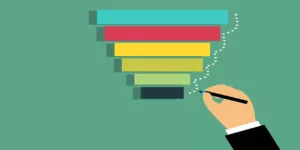Luring customers to your website, convincing them to make a purchase, and finally converting them to be returning customers. This is the customer trifecta you want to achieve. However, there are many areas between visiting your website and making a purchase where you may lose a potential customer. Creating the perfect eCommerce sales funnel will let you track how your customers are navigating through your website. This way, you can identify different ways to guide and keep your customers moving towards the checkout page.
Sales Funnels and Why They Are Important
A sales funnel refers to the various stages the customer has to go through from first interacting with your brand to making a purchase. The top of the funnel is the widest part where new prospects and customers enter. They move through different steps as they browse your product, consider its usefulness and prices, and eventually make a decision. This brings them to the bottom of the funnel: making the purchase. On your eCommerce website, these stages can be different pages or marketing strategies utilized to maintain your customers’ interest in your product.
Sales funnels can be studied and analyzed to attract new customers and maintain existing ones. By implementing analytics tools, such as Google Analytics, you can identify holes in the funnel where customers drop out. In short, funnels can be utilized to convert website visits into purchases and returning customers. So, what are the key stages to keep in mind when creating the ideal eCommerce sales funnel? Keep reading to learn more!
Stage 1: Let Them Know You Exist (Awareness)
Before anything else, your customers should know you exist. In some cases, customers may not even know that they have a problem that your brand can solve. It is, therefore, important to promote your brand in order to generate traffic to the website. You can create social media accounts to start. Another great option is to get a business phone number from a service provider like Global Call Forwarding or Koala Calling. Both companies offer local and toll-free numbers which are very useful for outreach.
Another way to generate traffic is by running effective ad campaigns. Invest in social media paid ads, pay-per-click, and Google-responsive ads. Make your brand pop-up on as many screens and pages as possible. This is very important for building awareness and familiarity.
It’s also important to produce content that highlights a problem your target customer can relate to and then introduce your brand as the solution. Optimize your website and content to rank higher in search results by adopting search engine optimization (SEO) techniques. The higher you rank, the more accessible your content and website becomes to viewers searching for a solution you can provide.
Lastly, consider holding promotional and informational events for local customers. Events are a good opportunity to interact with your prospects on a face-to-face basis. This can help them with any queries or concerns they may have.
Stage 2: Generate and Maintain Interest
Now, once you’ve got customers’ attention, it’s time to keep that interest going. First, gather their contact information through newsletters or pop-up sign-up boxes. The purpose of this is to open a channel of communication to give customers that extra push towards making a purchase. It is important to maintain several modes of communication so that your customers can easily reach you.
Keep in touch with phone numbers by advertising your number on billboards, landing pages, websites, emails, social media, etc. Businesses with a global consumer market should consider international toll free numbers to give customers a cost-free way to call. Essentially, companies offering call forwarding services can hook you up with a local virtual phone number for any country. For instance, businesses in the United States can get a UK phone number, gaining access to the UK consumer pool.
Another way to stay on your prospective consumer’s radar is through automated emails. Services such as Mailchimp help you set up automated emails to go out to customers who sign-up or start browsing product options on your website. Such services can be used to send out promotions, discounts like “First Time User” discounts, and reminders about products the customer was interested in. All of this is meant to keep the brand and product on the customer’s mind. Emails also make your brand more familiar to customers, as most people prefer working with brands/ companies they know.
Stage 3: Make Your Brand More Desirable
This stage is when customers have completed browsing products, compared and evaluated them, and put them in the cart. But that’s it. They don’t make the purchase, leading to cart abandonment. At this point, you know that your customer is clearly interested in your product. They just need some extra nudging and encouragement to go ahead and buy the product.
Here’s where automated emails come in handy again. Send targeted emails reminding customers of the item they want so badly. You can also choose to offer a promo code with a time limit, which will further entice them to complete the purchase. After all, who doesn’t love a good discount?
Stage 4: Completing The Purchase
This is the final step: completing the checkout process. Often, when customers reach this point, you can be certain that they will go through the process. However, you don’t want to give them any reason to back out. The best way to help your customers through the checkout process is to design the quickest and easiest process. Your checkout process should not be more than 1-2 pages and should have a progress bar that customers can follow. Additionally, offer multiple payment methods so that consumers can pay using the most convenient option.
Make Them Come Back For More!
The goal is to guide prospects to the very end where they purchase a product and then convince them to return. Consider creating rewards or loyalty programs or special members’ discounts. Make these customers your brand’s fans and advocates, as this will drive up referral sales. With a perfect eCommerce sales funnel, you can hook your customers to your product, reward them, and keep them coming back for more!
Author: Meryl D’Sa
Author Bio:
Content writer, Meryl D’Sa, writes about travel, culture, fashion, relationships, literature, business, and communications.








